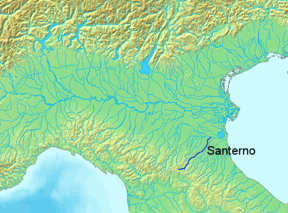Santerno
| Santerno | |
|---|---|
 The Santerno river | |
| Origin | Tuscan Apennines, Italy |
| Mouth | Reno River |
| Basin countries | Italy |
| Length | 103 km (64 mi) |
| Avg. discharge | 16 m³/s |
| Basin area | c. 700 km2 (270 sq mi) |
The Santerno is a river of Romagna,[1] in northern Italy, the major tributary of the Reno River. In Roman times, it was known as the Vatrenus (small Renus), although, in the Tabula Peutingeriana, it was already identified as the Santernus.
It rises near the Futa Pass, at 1,222 metres of elevation, in the Apennine ridges facing the plateau of Firenzuola. Beyond Firenzuola, it flows through Castel del Rio, where it is crossed by a famous medieval bridge, the Ponte degli Alidosi; then it flows past Fontanelice, Borgo Tossignano, Casalfiumanese, and, once in the Pianura Padana (the Po River's valley), Imola. Then it empties into the Reno, seven kilometres from Bastia.
It is probable that, in ancient times, the river flowed eastward from Bagnacavallo, as confirmed be the existence of a frazione of Ravenna called Santerno. In those days, after Imola, the river divided into two branches, one moving northeast toward Ravenna, the other continuing northward to join the Po. The Ravenna branch disappeared, most likely in the eighth century.
Once the late course of the river was modified, and protective measures were taken in the 1880s, the Santerno was famous for its serious floods. Fourteen were recorded between 1679 and 1778.
Footnotes
Coordinates: 44°34′N 11°58′E / 44.567°N 11.967°E